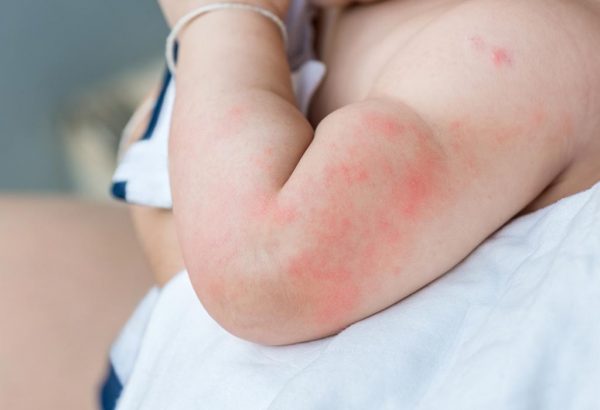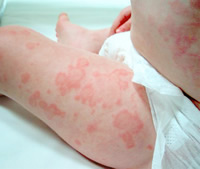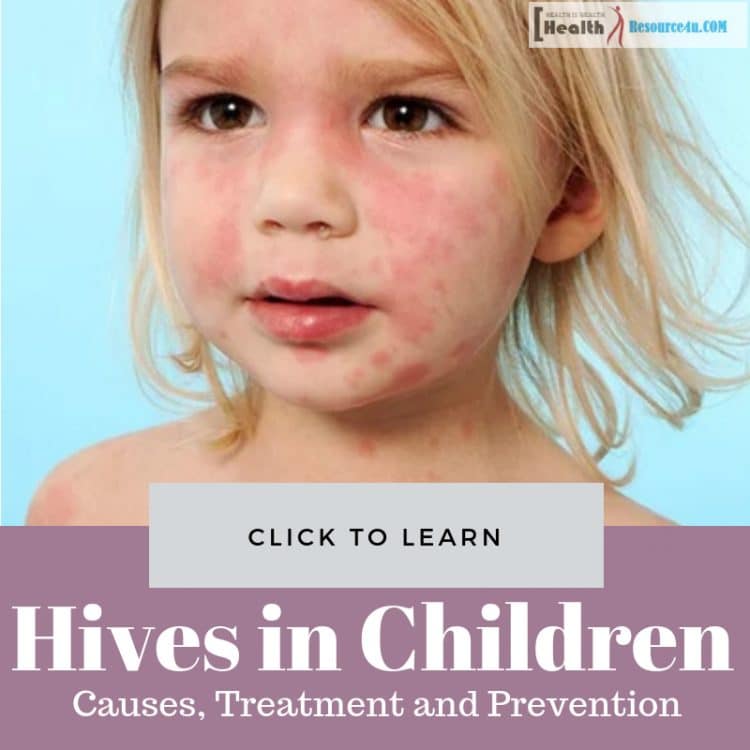You child can develop pale red bumps or wheals on their skin without any particular reason. This can be hives which are also known as Urticaria. These raised appearances on your infant skin may last for a few hours to some days or even for one or two weeks. These itchy raised bumps are really very annoying and can disturb your child’s well being. However, with immediate treatment of hives, it can be relieved easily.
Mostly hives cause itching but it can also sting or burn. This allergic reaction of the body can develop at any part of your body including lips, ears, tongue or throat. Its size varies from as small as a pencil eraser to as large as a dinner plate.
Hives usually develop when your infant comes in contact with allergens (foods, medicines, etc), due to any bug bite, a bee sting or due to an infection. In many cases, hives symptoms disappear on their own without any medical treatment or house treatment. However, this doesn’t happen every time and sometimes the symptoms turn very problematic which needs immediate medical intervention in order to relieve it.
Angioedema is a condition which is very much similar to hives however in this particular inflammation swelling occurs below the skin surface instead of the skin surface as it happens in the cases of hives. In the cases of Angioedema swelling occurs around the lips, eyes and in some cases, it develops on genitals, feet, and hands as well.
If the angioedema develops in the throat, tongue, and lungs then it can create a life-threatening scenario by blocking the normal airways leading to difficulty in the breathing process. However, that is a very rare scenario.
Causes of Hives
Table of Contents

- Bacterial Infections- Several bacterial infections are associated with hives symptoms in the body.
- Viral Infections- A virus infused hives health issue in children generally develops in much acute form than the adult people. Upper respiratory infection, cold and gastrointestinal virus can stimulate hives concern in infants and children.
- Medications- Certain medications doses can trigger hives reaction in infants and children such as antibiotic medicines and nonsteroidal anti-inflammatory medications, etc.
- Bug Bites or Bee Stings- Hives symptoms can easily develop in your children if any bug bites your child or due to an insect sting.
- Foods- Foods are the most prominent reason behind the hives reaction in an infant’s body. Your infant can react to certain food either while consuming it or even after digesting it. Foods which generally causes a reaction in children include milk, nuts, berries, shellfish, eggs, etc.
- Weak Immunity System- Infants and little child have very weak and immature immunity system this is the reason they easily react to any food or thing which comes in their contact. However, as they grow their immunity power gets boosted and improves hence their tolerance level increases for new things as well as for the old things which previously used to cause allergy to them.
- Environmental Components- Environmental changes can also trigger to hives symptoms in your child such as changes in weather like cold or hot environment either on the surrounding level or on wider aspect means overall atmosphere.
- Other Allergens- Some external factors can irritate the skin of your child leading to the growth of hives symptoms such as irritants like certain specific fragrances, chemicals, pollen and pet irritants, etc.
In the cases of mild hives, the symptoms will automatically disappear just within 24 hours. In this particular condition, you easily trace that what new material or products contact has caused your child this infection. For example, you can easily identify whether your child has used any new soap or lotion, any food they have eaten, or they touched any poisonous plant that has caused a reaction on their skin.
Signs and Symptoms of Hives
The red raised welts are the primary signs of hives in your children The welts appearance vary from person to person depending upon the intensity of reaction and the factors responsible for this skin reaction. Usually, the welts can be-
- Very tiny or as large as a dinner plate.
- Appears in cluster
- It has a pale center
- The size and location of welts can be changed within a few hours.
- It causes itching and irritation.
- It can cause burn and sting sensation.
If anyone develops angioedema along with hives then they can develop symptoms like bumps, blotchy redness, puffiness or swelling around eyes, lips, throat, hands, feet, and genitals. Apart from this, the affected child can also develop nausea, vomiting and belly pain.
Under the rare scenario, a person who has developed hives and angioedema can also get affected with Anaphylactic shock. In this case, the affected person can develop symptoms like dizziness, loss of consciousness, fall in blood pressure rate and difficulty in breathing.
Hives Diagnosis

In the cases of chronic hives, you need to maintain a detail report of daily life activities of your child such as the meals that your child eat or drink, etc. Some common diagnostic test that is required to confirm the hives reaction especially chronic hives includes a blood test, allergy test and also the test for other health conditions that can contribute to hives symptoms such as hepatitis and thyroid disease, etc.
These tests will help a healthcare specialist to analyze the actual cause of hives which is really very difficult to trace. In order to diagnose physical hives, a doctor can perform certain test like they can put ice over your child’s skin to see how it reacts to a very cold substance contact. Similarly, they can place a heavy object over your child’s skin such as sandbag to detect whether any pressure is causing hives reaction on your child’s body or not.
Hives Treatment
In the cases of mild hives, there is no specific treatment is required and it automatically disappears after some hours like within 24 hours. In these cases, if any triggering factor is detected by the parents then avoidance of those triggers can speed up the recovery period.
For relieving the itching discomfort which is the most common symptom of hives a doctor may prescribe for over the counter antihistamine or non-sedating medicines which requires to be taken every day. However, there is no surety that the first hand prescribed medication will work effectively over your children hives symptoms. In such condition, you can consult with your doctor to prescribe for appropriate medication for your child.
In the cases where non-sedating histamine doesn’t show any significant improvement in your child’s condition then a doctor may prescribe a strong dose of antihistamine with a combination of some other medicines to improve the condition of your child.
In the cases of chronic hives, a healthcare specialist may prescribe for steroid pill or liquid. When this happens then the doses periods are limited to 5 days to 2 weeks in order to avoid the negative impacts of steroid medications on your child’s health.
For the treatment of hives even home care and treatment also play an important role. In fact, in many cases, the condition of a child improves with active home care treatment by parents.
Medical Treatments
If your child has developed hives symptoms then you can use over the counter medications to treat it such as cetirizine (Zyrtec), diphenhydramine (Benadryl), etc. These medications you can avail easily without showing any doctor’s prescription.
In the cases where an infant has developed the hives symptoms, consultation with a doctor is must before using any over the counter medicines as they can only say better whether it is safe for your infant or not. There are some medications which are not approved for use in child aging under the age of 2.
In the case you are using antihistamine then you need to have a constant watch over your child to see the changes and improvement in their symptoms. This process will continue for a few times in a day and for several days until the symptoms show the sign of improvement and relieved fully.
In the cases of the chronic hive, occasionally steroids are required to be used as in such cases hives symptoms doesn’t relieve with a sole application of antihistamine. In the cases of more complicated symptoms like breathing trouble, congestion of throat or wheezing immediate medical attention or hospitalization is required as these are life-threatening conditions.
It especially happens when hives are accompanied by Angioedema or Anaphylactic shock. However, these are very rare scenarios still if it happens in any child this calls for an emergency situation and treatment.
In the cases of a severe allergic reaction, your child requires to inject an injection where the concerned patient may require to carry the prescribed injection. In such cases, a doctor will guide you on how to give an injection so that you can yourself inject your child at the right time to avoid an alarming situation.
Home Treatments or Remedies
Home remedies or treatment that partners can themselves conduct in order to relieve the symptoms and condition of their children affected with hives are mentioned below.
- Over the Counter Oral Histamine- The uses of over the counter oral histamine helps in relieving itching and discomforts caused by red, raised bumps on the skin. In this case, parents should follow the mentioned doses direction as mentioned over the label of these medications.
- Reduce the Scratching- Scratching may more elevate the condition of your infant or child. So make sure that your child doesn’t scratch over their bumps. For this, you need to have a constant watch over your child’s activity. Also, you can cut the nails of your child to avoid the scratching risk. Other than that you can apply anti-itching cream over the hives to reduce the itching intensity and frequency.
- Apply a Cool Washcloth Over Hives- You can apply a cool washcloth over your child’s hives in order to give him or her instant relief from burning and sting sensation with its cooling effect.
- Give Your Child a Lukewarm bath- Though your child has developed hives rashes and bumps however it doesn’t mean that they cannot bathe. However, you should always use lukewarm water for the bathing purpose as it will soothe and calm the discomfort of your child’ hives along with body cleaning.
Extend the bathing time up to 10 minutes as it will help in easing the discomfort associated with hives symptoms. You can use a certain itching relieving product with colloidal oatmeal in water.
Also use only a gentle, fragrance-free cleanser to avoid the triggers which may happen with a chemical loaded soap application. After bath pat, your child dry with a soft towel and apply a gentle lotion or cream over the damp skin
- Keep Your Child Away from the Triggers- If you have identified any trigger or have suspected and triggering factor then you should restrict the exposure of your child to the said triggers. Also, maintain a diary of your child’ daily foods and medicines routine to identify any hidden trigger so that you can avoid them further.
- Maintain a Comfortable Surrounding for Your Child- The surrounding environment of your child should be very comfortable one in order to ease the symptoms off hives. For example, in summer season you should keep your child in the room which has the air-conditioning in it, use a humidifier in the room during the winter season.
Also, the dress of your child must be comfortable one like cotton clothes with loose-fitting. If possible cover the affected area to avoid the scratching rick otherwise it will elevate the rashes. However, while covering the affected area make sure that it remains cool all the time.
Hives is a very common skin health condition in children however for the appropriate treatment of hives it is very crucial that every parent should have a clear understanding of its symptoms. Also, they should maintain prevention so that their children won’t have to suffer from the discomfort of this particular health condition.
[expand title=”View Article Sources“]
- https://www.healthline.com/health/baby/hives-on-baby
- https://www.parents.com/health/rashes/how-to-treat-hives/
- https://kidshealth.org/en/parents/hives.html
- https://www.aad.org/media/news-releases/dermatologists-share-tips-for-treating-hives-in-children
[/expand]

